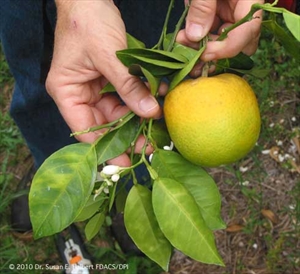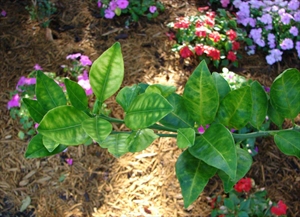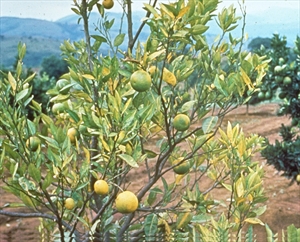Citrus greening, citrus huanglongbing (greening) disease.
Pacific Pests, Pathogens, Weeds & Pesticides - Online edition
Pacific Pests, Pathogens, Weeds & Pesticides
Citrus Huanglongbing (greening) (230)
Candidatus Liberibacter asiaticus (Asian form), Candidatus Liberibacter africanus (African form), and Candidatus Liberibacter americanus (South American form). The three pathogens can only be distinguished by molecular tests. The abbreviation is HLB. The name 'huanglongbing' means 'yellow shoot disease'.
The Asian strain of huanglongbing disease is found in Asia, Europe (Netherlands only), the Middle East, North, South and Central America, the Caribbean, Oceania (Papua New Guinea only). The African strain is found in Africa and the Middle East. A third, American strain, is found only in Brazil.
The Asiatic citrus psyllid (Diaphorina citri) that spreads the bacterium of the Asian strain is present in American Samoa, Papua New Guinea, and Samoa.
All species and varieties of citrus are affected, such as orange, grapefruit, mandarin, tangelo, kumquat, lemon, lime, pomelo, trifoliate orange and tangelo. Mock orange or orange jasmine (Murraya paniculata), and the curry tree (Bergera koenigii) are also hosts.
The damage is done by a bacterium, Candidatus Liberibacter species. Spread is by the Asian psyllid, Diaphorina citri (see Fact Sheet no. 185), or in Africa by Trioza erytreae.
HLB causes a yellowing of leaves, and this can be confused with nutritional deficiencies, especially lack of zinc. However, there are two important differences. First, early symptoms of HLB yellowing often appear on a single shoot or branch, and then spreads randomly in the tree canopy over several years. This is in contrast to nutritional deficiencies which usually occur uniformly throughout the canopy.
Secondly, HLB leaves show what is called 'blotchy mottle'. The patches of yellow (i) cross the veins and (ii) are lop-sided, i.e., are often more on one side of the leaf then the other, and (iii) are most obvious on newly hardened leaves, and fade with age (Photos 1&2). Leaves with nutritional deficiency, zinc for instance, show a general yellowing throughout the leaf (Photo 3).
If branches become severely infected, leaves show what is called 'rabbit ears': small upright shoots with short internodes (i.e., the distance between leaves is shorter than usual).
These symptoms are followed by premature leaf drop, twig dieback, decay of feeder and lateral roots, decline in vigour and, ultimately, death of the entire tree. Affected trees have stunted growth, bear multiple off-season flowers (most of which fall down), and produce small, irregularly-shaped fruit with thick pale peel that remains green at the bottom (hence the other name of 'greening' for the disease) (Photo 4). Fruit from these trees tastes bitter.
Spread of the disease is by psyllids which become infected by the HLB bacterium as they feed. Both adults and nymphs spread the disease throughout a life of 1-2 months. Long distance spread occurs by the movement of infected citrus planting material as well as infested psyllids. The pathogen can also be spread by grafting, and possible by seed. Movement of other host plants, such as orange jasmine (Murraya paniculata) and curry leaf (Bergera koenigii) also poses a risk of introducing HLB and psyllids to new areas, as happened in Florida.
Tropical storms and cyclones could also spread the psyllid, and may explain the occurrence of the psyllid in Samoa.
The two HLB strains, African and Asian, differ in their sensitivity to temperature. The African strain is heat sensitive with no symptoms developing above 25-30°C; it occurs at elevations above 600-1000 m in Kenya, Madagascar, South Africa, and Yemen. By contrast, the Asiatic strain is heat tolerant occurring at low elevations in hot climates (symptoms occur above 30°C).
HLB is one of the most important diseases of citrus, whether grown commercially or for home use. Wherever the disease has occurred it has seriously affected citrus production with the loss of millions of trees. It is estimated that since the 1990s more than 60 million trees have been destroyed worldwide. Widespread losses are reported from Brazil (hundreds of thousands of trees have been removed since 2004), Indonesia (all mandarin trees have been killed in Bali), the Philippines, India, Nepal, Saudi Arabia (all mandarin and sweet orange have been destroyed). The disease now threatens production in Florida (introduced 2005) and California (introduced 2012). Invariably, where the insects have appeared the disease has followed a few years later.
Citrus trees may show symptoms before they reach 10 years and, as the trees decline and die, they are often replaced, only for the replants to become infected, and needing to be replaced again, greatly adding to production costs.
The disease is not easy to recognize in the field. Look for a yellowing tree canopy, blotchy mottled leaves often with yellow patches that are one-sided, and small lopsided fruits with lower parts that remain green and with dark aborted seeds (Photo 5).
Molecular tests are needed to confirm the presence of the bacterium in trees and insects.
Look at the new growth as shoots flush. Do this every month. Look at the youngest leaves. Look for signs of psyllid feeding and damage, including twisted leaves, waxy deposits, honeydew, sooty mould and adult psyllids. If psyllids or symptoms are seen, contact quarantine authorities immediately.
QUARANTINE
There is no known cure for HLB, and the only way to protect citrus is to prevent introduction and spread of the disease in the first place. If the quarantine barrier is breached, then it is necessary to control the psyllid, and to destroy infected trees. If countries wish to import citrus germplasm, it should be under strict conditions following the FAO/IBPGR Technical Guidelines for the Safe Movement of Citrus Germplasm: http://www.bioversityinternational.org/e-library/publications/detail/faolbpgr-technical-guidelines-for-the-safe-movement-of-citrus-germplasm/. Note, more advanced techniques using PCR (polymerase chain reaction) are now part of indexing procedures.
NATURAL ENEMIES
The nymphs are killed by parasitic wasps and predators including ladybeetles - larvae and adults - syrphid fly larvae, and pirate bugs. In California, a biological control program has been established using two parasitoids from Pakistan, Tamarixia radiata and Diaphorencyrtus aligarhensis, which attack the psyllid nymphs. See: http://calag.ucanr.edu/Archive/?article=ca.2017a0027. Introduction of Tamarixia radiata has to be done with care, as there are hyperparasites that attack it.
CULTURAL CONTROL
Cultural controls are important. Citrus should be monitored for huanglongbing and psyllids. It should be done to confirm that they are not present, or if they are present whether they are spreading. It is usual for the psyllid to be found first, and then 1-2 years latter the disease appears. An IPM program against this disease requires (i) disease-free nursery plants, (ii) monitoring, and (iii) removal of infected trees (i.e., those with symptoms).
- Check that plants supplied by commercial or government nurseries have been tested for huanglongbing bacteria and important viruses. The use of certified healthy trees is important in the management of the disease. It is also important that as part of the certified healthy tree program the nursery stocks are grown under psyllid-proof screenhouses.
- Do not allow ornamental plants that are hosts of huanglongbing and psyllid, for instance, orange jasmine (Murraya paniculata) and curry leaf (Bergera koenigii), to be moved from areas where the disease and/or insects occur.
- It is important to monitor citrus for disease symptoms and for the presence of the psyllid. Monitoring should be done by farmers (preferably monthly if in a disease area, otherwise every 3 months), and also by quarantine authorities using yellow sticky traps placed in the tree canopy. Citrus growers should be trained how to do this. Early detection of the disease and the psyllid is very important. If diseased trees are found they should be removed, and burnt, but before removal they should be sprayed with the chemicals listed below to prevent spread of the psyllids.
CHEMICAL CONTROL
In the USA, two insecticides are applied in areas where the psyllid is found:
- Spray trees with a pyrethroid (e.g., lambda-cyhalothrin) insecticide to kill the adults and nymphs. Malathion can also be used.
- Spray the ground around trees with a systemic product (e.g., imidacloprid) so that it is taken up by the roots to kill nymphs in the folds of leaves in the canopy. Note, do not use imidacloprid when trees are flowering as it is toxic to bees.
- As an alternative to synthetic products, use 'soft' insecticides, e.g., horticultural spray oil, neem or insecticidal soap (see Fact Sheets 56).
- These treatments give protection for 9-12 months.
____________________
When using a pesticide, always wear protective clothing and follow the instructions on the product label, such as dosage, timing of application, and pre-harvest interval. Recommendations will vary with the crop and system of cultivation. Expert advice on the most appropriate pesticides to use should always be sought from local agricultural authorities.
AUTHOR Grahame Jackson
Information from Briansky RH, et al. (2014) Florida citrus pest management guide: huanglongbing (citrus greening). U.S. Department of Agriculture, UF/IFAS Extension Service, University of Florida. (http://edis.ifas.ufl.edu/cg086); CABI (2019) Citrus huanglongbing (greening) disease. Crop Protection Compendium. (https://www.cabi.org/cpc/datasheet/16567); and from (including Photos 1&3) Citrus Greening (Huanglongbing) (2019). UF/IFAS Citrus Research and Education Center. (https://crec.ifas.ufl.edu/hlb-information/greening/); and information (and Photo 2) Grafton-Cardwell EE, Daugherty MP (2018) Asian Citrus Psyllid and Huanglongbing Disease (2013) University of California Statewide IPM Program. Agriculture and Natural Resources, University of California. (http://www.ipm.ucdavis.edu/PMG/PESTNOTES/pn74155.html). Photo 4 HD Catling, Bugwood.org. Photo 5 Jeffrey W Lotz, Florida Department of Agriculture and Consumer Services, Bugwood.org.
Produced with support from the Australian Centre for International Agricultural Research under project PC/2010/090: Strengthening integrated crop management research in the Pacific Islands in support of sustainable intensification of high-value crop production, implemented by the University of Queensland and the Secretariat of the Pacific Community.








